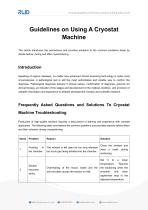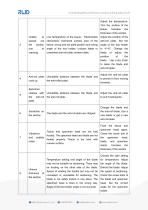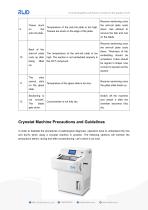 Website:
RWD Life Science
Website:
RWD Life Science
Catalog excerpts

Guidelines on Using A Cryostat Machine This article introduces the precautions and provides solutions to the common problems faced by clients before, during and after cryosectioning. Introduction Speaking of organic diseases, no matter how advanced clinical screening technology is under most circumstances, a pathological test is still the most authoritative and reliable way to confirm the diagnosis. Pathological diagnosis delivers 5 clinical values- confirmation of diagnosis, grounds for clinical therapy, an indicator of the stages and development of the medical condition, and provision of valuable information and experience to disease development, therapy and scientific research. Frequently Asked Questions and Solutions To Cryostat Machine Troubleshooting Production of high-quality sections requires a long period of training and experience with cryostat application. The following table summarizes the common problems and provides reasons behind them and their solutions during cryosectioning. Items Problem Frosting The window is left open for too long whereas too much gas being exhaled into the chamber. Solution Close the window and wear becomes sticky. Overheating of the tissue, blade and the anti-roll plate causes the section to melt. appliances drop to the adjusted temperature.
Open the catalog to page 1
Adjust the temperature. Trim the surface of the tissue. thickness of the section. Unable spread interactions Oversized surface area of the tissue; wrong anti-roll plate position and wrong angle of the tool holder angle of the tool holder; unclean blade or unwashed anti-roll plate; broken blade. position blade. to clean the blade and anti-roll plate. Anti-roll plate Unsuitable distance between the blade and Adjust the anti-roll plate to prevent it from moving forwards. Unsuitable distance between the blade and Adjust the anti-roll plate plate. Change the blade and 6 The blade and the...
Open the catalog to page 2
Resume sectioning once Tissue stuck 9 anti-roll plate. Temperature of the anti-roll plate is too high. Tissues are stuck on the edge of the plate. the anti-roll plate cools down. Use ethanol to remove the fats and rust on the blade. Resume sectioning once the anti-roll plate cools Back of the anti-roll plate curls up after high. The section is not embedded properly in The temperature of the anti-roll plate is too the OCT compound. down. Thickness of the embedding consistent. It also should be regular in shape. Use a brush to spread out the section. Temperature of the glass slide is too low....
Open the catalog to page 3
Before Cryosectioning Please be aware that cracking of tissue will occur if the tissue is frosted for too long. Lock the blade cover and specimen head. Then, keep the blade mounted and locked before cryosectioning. Before frosting the sample, it should be embedded in the OCT compound and the specimen should be placed beneath the bottom of the OCT box. The section should be well integrated into the OCT compound. If the OCT process is done properly, it can save a lot of time for trimming the tissue and increase the durability of the blade. During Cryosectioning After ensuring that the machine...
Open the catalog to page 4All RWD Life Science catalogs and technical brochures
-
RWD Gradient Thermal Cycler
2 Pages
-
Rotary Microtomes S710
2 Pages
-
RWD Osmotic infusion Pump
2 Pages
-
RWD Syringe Pump R462
1 Pages
-
RWD Rotating impactor 68099Ⅱ
2 Pages
-
RWD Microcentrifuge M1324R
2 Pages
-
RWD Infusion imager RFLSI Ⅲ
2 Pages
-
RWD Surgical Instruments
18 Pages
-
RWD Veterinary medical equipment
32 Pages
-
RWD R415 Animal Ventilatorr
1 Pages
Archived catalogs
-
PRODUCT CATALOGUE 2017
51 Pages
-
2015 Product Catalogue
44 Pages


















































































